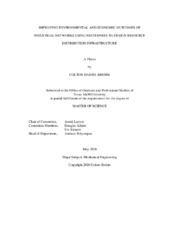| dc.description.abstract | The sustainability of industrial practices is a growing point of emphasis in the research and business communities demanding effective systems-level solutions. EcoIndustrial Parks (EIPs), networks of co-located industries connected through mutually beneficial material and energy flows are a popular systems-level solution, but have experienced variable degrees of success. Some EIPs fail to establish complex resource networks, while others fall victim to cascading failures due to the sharing of infrastructure. This thesis focuses on using bio-inspired network-level metrics to provide design advice to industrial designers looking to invest in EIP infrastructure such as power lines, pipelines, and railways to move material and energy in a circular economy. Nestedness is identified as a novel design objective for EIPs with the hypothesis that the infrastructure patterns in an industrial network can achieve a more sustainable behavior by mimicking the nested interactions found in ecological networks. The results show that the infrastructure of EIPs is distributed “randomly” amongst industries, while food webs distribute interactions among species in a significantly nested way, especially for predators/consumers. The results also show resource cycling, measured by the metric cyclicity, could be maximized by nesting the resource flows in EIPs similar to what is seen in nature. This aspect was central to the consilience of reducing network resource use while minimizing investment and operating costs to maintain resource cycling in an EIP.
Results from generated EIP water networks further support these results, showing reduced freshwater use and total cost (pumping, installment of pipelines, and freshwater import) for highly nested networks when compared to random and anti-nested networks. Nestedness is a metric decision makers, such as plant managers for example, can consider when balancing the goals of their industry with the network outcomes for all actors in an EIP. The constraints for this EIP design advice are given in terms of mean geographic dispersion of industries in the EIP. Analyzing the geographic dispersion of industries provides a novel perspective that many researchers have considered, but not made results driven conclusions regarding its impact on investment cost. This thesis provides conditions under which nesting infrastructure will most reduce resource imports and how increasing nestedness can decrease the investment, operating, and raw material import costs for an EIP. | en |


